Almost 90% of all flowering plants depend on animal pollinators for fertilization and approximately 200,000 species of animals perform as pollinators. Of those, 1,000 are hummingbirds, bats and some animals, like mice. The rest are insects, such as bees, butterflies, beetles, flies, moths and wasps. Most people are aware that bees and butterflies are important pollinators, but let’s explore some of the lesser known pollinators.
Beetles are among the earliest pollinators, visiting flowers 50 million years before bees. Magnolias, one of the earliest known flowering plants, are one of the plants they pollinate — not by sipping the nectar, but by eating parts of the plant. Tyler has a grove of magnolias, located north of the parking area, which attract visitors in spring not only by its beauty, but also by its wonderful fragrance.
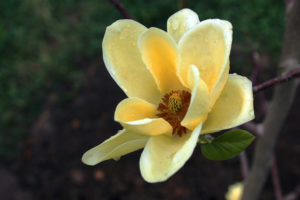
The spicebush is also pollinated by beetles. Known as a host plant for spicebush butterflies, the spicebush fruit is a favorite of many songbirds. Scattered throughout Tyler, spicebushes can be found in the North Woods and the Native Woodland Walk. Appropriately, there is also a spicebush in the center of the butterfly house.
Pawpaws are the largest edible native fruit found in the United States and were a favorite treat of the early settlers. They are pollinated by both beetles and flies. The flowers smell like rotting flesh, which attracts blowflies. The pictured carrion beetles in turn cross-pollinate the pawpaw. Young pawpaw leaves are the exclusive food of zebra swallowtail caterpillars. Tyler’s pawpaw trees can be found on both the Native Woodland Walk and in Lucille’s Garden.
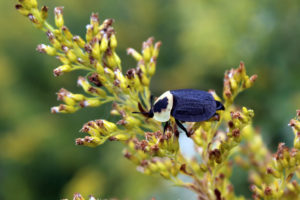
A common woodland plant that is pollinated by both flies and carrion beetles is skunk cabbage. The skunk cabbage’s unpleasant odor, likened to rotting flesh, attracts the pollinators. Although this plant is not recommended for humans, it is eaten by animals such as snapping turtles, bears, wood ducks and snails. Tyler has an abundance of skunk cabbage which can be found in the woodlands, particularly along Rocky Run. Goldenrod is also pollinated by beetles. The goldenrod soldier beetle, aka the Pennsylvania leather wing beetle, feeds on the pollen and nectar of the goldenrod, milkweed and many other flowers. As an added bonus, they or their larvae also eat aphids, caterpillars and insect eggs. Goldenrod blooms in late summer. Its bright yellow blossoms are easy to spot in the Stopford Family Meadow Maze and the meadow across from the Service Facility.
Flies are only second to bees as critical pollinators and nearly half of the 150 fly families visit flowers. Flies are known to pollinate coffee, tea, bananas and mangoes. Many flies, like the hoverfly, look like bees to the casual observer. Hoverflies are important pollinators of fennel, carrots, parsley and dill found in Lucille’s Garden and the Herb Garden. As larvae, they eat aphids which is also a plus for any garden. Midges, a type of fly, is the only known pollinator of the cacao tree, which produces cocoa beans. Mosquitoes, also a type of fly, drink nectar. Whenever an insect drinks nectar, there is a good chance that pollen is transferred. Mosquitoes are known to pollinate certain orchids. Flies also boost pollinating in alpine and arctic environments where bees tend to be less active.
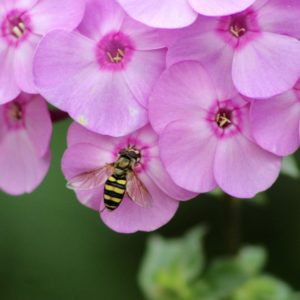
Nectar is almost the only food for adult moths. Moths are mostly nocturnal and often pollinate pale or white flowers that open at night. Emitting a strong scent, particularly at night, gardenias attract moths to pollinate them. Their white flowers reflect the light making them easier for moths to find. There are several gardenias at Tyler, including one near the visitor center. Tobacco plants open their flowers at night to attract hawkmoths. Some moths, such as the hummingbird moth, are active in daylight. They have a long tongue, called a proboscis, to insert into flowers and can hover over a flower just like a hummingbird. They enjoy the nectar from several different flowers, including bee balm and milkweed. The yucca moth not only pollinates yuccas, but lays her eggs in the yucca. When the yucca produces seeds, the moth larva feed on them.
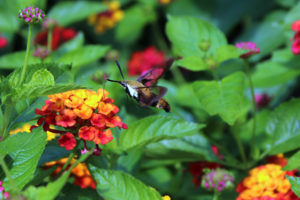
Wasps may look like bees but they are not covered with fuzzy hairs. Because wasps don’t have hair for the pollen to cling to, they are not as good of a pollinator as are bees. However, there are many plants that depend on wasps to pollinate them. The blue mud wasp pollinates Queen Anne’s lace, which you can find in the Stopford Family Meadow Maze. A very specialized pollinator is the fig wasp. Fig flowers are contained inside the immature fruit. The fig wasp enters the fruit, mates, lays eggs and pollinates the tiny flower. Without the fig wasp, there would be no figs.
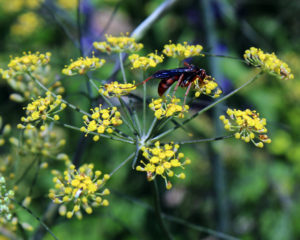
Pollinators also play a crucial role in the production of our food. The Food and Agriculture Organization of the United Nations estimates that 75% of the world’s food crops depend on pollination. Pollinators also contribute to crops that provide fiber (cotton), biofuels (canola and palm oils), forage for livestock and medicines. According to the World Health Organization, 11% of the 252 drugs considered essential were exclusively derived from flowering plants.
Tyler Arboretum, and the rest of the world, would look a lot different if it weren’t for the work of these sometimes overlooked pollinators.
Regrettably, the existence of many pollinators is threatened by land development, pesticide use, alien invasive species and climate change. Unless something is done to reverse the damage being done to pollinators, we will not always be able to enjoy the wide diversity of food currently available to us.






